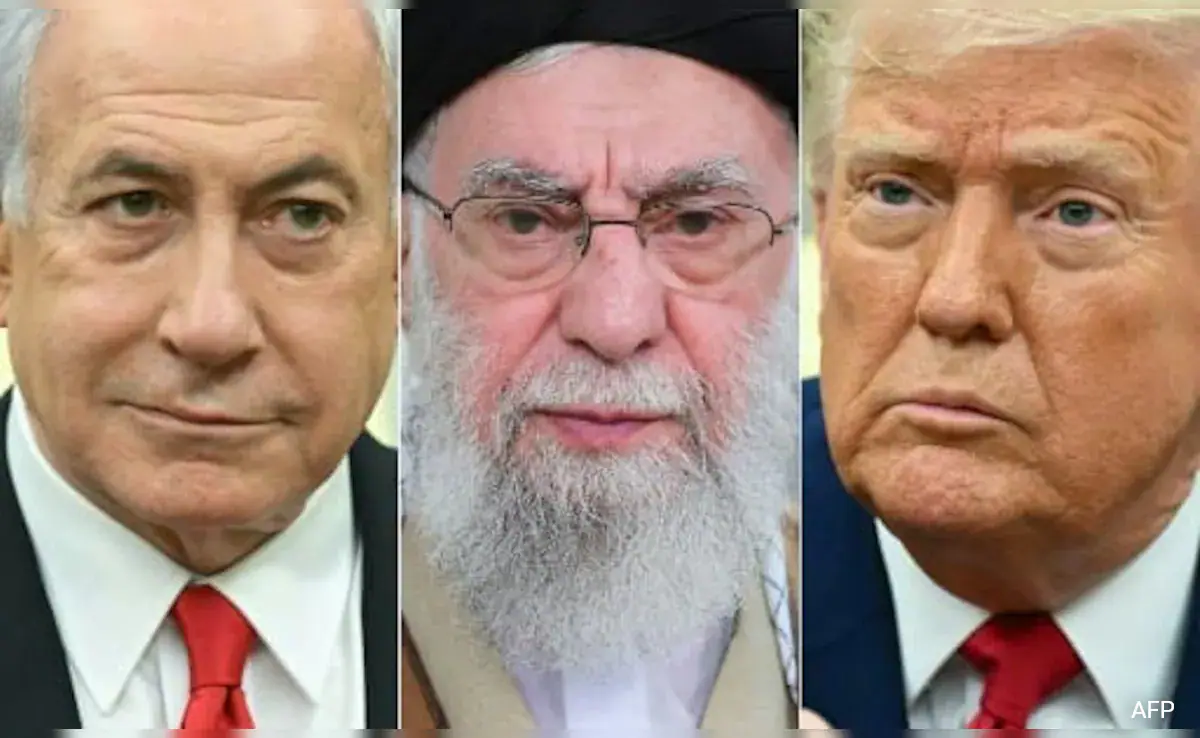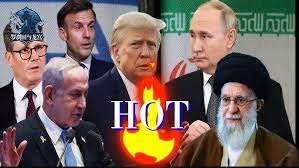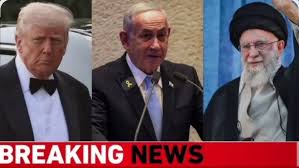
Latest Iran–Israel Tensions in 2025: War, Diplomacy & Risks
In June 2025, Middle East relations reached a tipping point as Israel and the U.S. conducted direct military strikes on Iran’s nuclear and missile infrastructure. Retaliatory actions by Iran, global diplomatic reactions, and escalating civilian risks have pushed the region toward possible all‑out conflict.
2. The Trigger: Operation Midnight Hammer
On June 22, 2025, the U.S. launched airstrikes on Iran’s Fordo, Natanz, and Isfahan nuclear sites, deploying B‑2 stealth bombers and bunker‑buster ordnance. The operation, termed Operation Midnight Hammer, was conducted in coordination with Israel to set back Tehran’s nuclear capabilities, not regime change nypost.com+3apnews.com+3apnews.com+3.
Iran’s Response
- Teheran condemned the action and vowed to retaliate, calling for global solidarity .
- Iran’s Parliament even considered closing the Strait of Hormuz, raising global trade fears dawn.com+2thetimes.co.uk+2en.wikipedia.org+2.
3. Israel’s Independent Campaign
Simultaneously, Israel escalated its own strikes targeting Iranian missile facilities and nuclear scientists via Mossad-coordinated drone raids voanews.com+10en.wikipedia.org+10thescottishsun.co.uk+10.
- According to Reuters, strikes hit military installations in Tehran, Rasht, and the Caspian region en.wikipedia.org+1timesofindia.indiatimes.com+1.
- Casualties included senior IRGC commanders, and Iranian missile barrages struck Beersheba and Haifa, injuring dozens en.wikipedia.org+2theguardian.com+2timesofindia.indiatimes.com+2.
4. Iran’s Strategic Retaliation

- Tehran launched a barrage of missiles into Israel, echoing direct military escalation .
- The launch of a new missile, Qassem Bassir—boasting 1,200 km reach—signified Iran’s tactical advancement en.wikipedia.org.
5. Human Toll & Civilian Impact
- A Sejjil missile hit the Soroka Medical Center in Beersheba, prompting evacuation and severe infrastructural damage theguardian.com+2en.wikipedia.org+2en.wikipedia.org+2.
- Iranian civilians started fleeing Tehran en masse, causing major disruptions and a reported 97% internet blackout en.wikipedia.org+1en.wikipedia.org+1.
6. Escalation Risk: Nuclear & Economic

The closing of the Strait of Hormuz disrupted 20% of global oil shipments, triggering fears of crude prices soaring toward $150/barrel en.wikipedia.org+1thetimes.co.uk+1.
7. Military Dynamics & Strategic Advantage
- Reports from Washington Post and AP detail how Israeli jets are now operating over Tehran with minimal resistance, representing a seismic shift in regional air supremacy washingtonpost.com.
- Israeli officials pledged a prolonged operation inside Iran and emphasized shifting strategic priorities theguardian.com+4apnews.com+4timesofindia.indiatimes.com+4.
8. Global Reactions & Diplomacy
Western Powers
- Europe, led by the UK, France, and Germany, is pushing for diplomacy. A June 20 Geneva meet aimed to de-escalate tensions time.com+1washingtonpost.com+1.
- UK and France called for immediate restraint, threatening international isolation if escalation continues thinktank.pk+1livemint.com+1.
Gulf States

- UAE and Saudi Arabia are working to buffer the crisis, especially with their uneasy diplomatic links to both Iran and Israel .
U.S. Position
- President Trump delayed further strikes while advocating negotiations, still keeping military options open within two weeks apnews.com+5time.com+5washingtonpost.com+5.
- Vice President Vance emphasized caution, fearing a drawn-out war apnews.com+2reuters.com+2timesofindia.indiatimes.com+2.
- Israeli President Herzog clarified that Israel seeks to deter Iran, not drag the U.S. into war politico.com.
Iran’s Diplomatic Moves
- FM Araqchi embarked on a diplomatic tour of the region, meeting Gulf and Western leaders tehrantimes.com.
- Iran publicly accused Israel of manipulating U.S. policy and destabilizing the region .
9. Regional Proxy Risks

- Hezbollah in Lebanon faces pressure to refrain, while Houthi rebels in Yemen, linked to Iran, have already targeted West Asian shipping lanes reddit.com.
- Gulf states, especially Jordan, engaged in indirect defense roles, highlighting broader regional involvement .
10. Possible Outcomes
- Escalation into full regional war — involving proxies like Hezbollah and Houthis
- Energy market shocks — rising fuel costs and global trade slowdowns
- Diplomatic backtracking — via Europe-led efforts and Oman-mediated talks nypost.com+15samaa.tv+15washingtonpost.com+15
- Long-term stalemate — with continuous military skirmishes and intermittent diplomacy
📌 Key Takeaways
- Direct U.S.-Israeli strikes represent a new level of confrontation.
- Iran is signaling retaliation, threats to shipping, and internal resilience.
- International voices are polarizing, with Europe urging diplomacy and Gulf states acting as intermediaries.
- Proxy escalation remains a real risk, with major geopolitical and economic consequences.
✅ What’s Next?
- Return to negotiation tables? Europe and Oman aim to mediate.
- Or rise in casualties and global instability, if Iran escalates further through proxies?
Let me know if you’d like:
- An SEO meta title and tags for this article.
- A social media teaser ready to share.
- A breakdown of site traffic strategies using the embedded links.
Your call! 😊
Latest News on Iran–Israel Tensions;

2 Responses
Ready to find authentic natural locs?
Discover the best natural dreadlocks at natural dreadlocks, your go-to shop for natural dreadlocks extensions online.
Our collection of natural locs offers premium-quality dreads made from 100% human hair, ensuring a natural look for any style. Whether you want natural grey dreadlocks or customized natural dreadlocks hair, we have the perfect set.
Why choose our natural dreadlock extensions?
– Real human hair for lasting beauty and natural feel.
– Handmade with care by skilled artisans to blend seamlessly.
– Available in various lengths and shades, including earthy hues.
– Suitable for protective styles
– Fast US shipping with tracking and support.
Buy natural dreadlocks that offer comfort and style. Our natural dreadlocks extensions are perfect for adding volume and length without compromising authenticity.
Explore the best natural dread products and take your hairstyle to the next level with realistic natural dreadlocks hair. Whether you are seasoned in natural hair styles, we provide products that celebrate your unique identity.
Order now from Looking for natural dreads for sale?
Discover the best natural dreads at natural dreadlocks extensions, your trusted source for dreads natural hair online.
Our selection of dreadlocks natural hair offers premium-quality dreads made from 100% human hair, ensuring a flawless blend for any style. Whether you want long natural dreadlocks or customized natural dreadlocks hair, we have just what you need.
Why choose our natural dreadlocks for sale?
– Real human hair for lasting beauty and natural feel.
– Expertly crafted by skilled artisans to blend seamlessly.
– Available in a wide range of colors, including classic natural tones.
– Suitable for long-term wear
– Fast US shipping with reliable service.
Buy natural dreadlocks that offer comfort and style. Our dreads natural are ideal for anyone looking to enhance their look without compromising authenticity.
Explore the finest natural dreadlocks collection and take your hairstyle to the next level with beautiful natural locs for sale. Whether you are new to dreadlocks, we provide quality, style, and expert guidance.
Order now from — your destination for natural dreadlocks. — where natural dread hair meets artistry.
Looking for authentic natural locs?
Discover the best natural dread hair at natural dreadlocks, your trusted source for buying natural dreadlocks online.
Our selection of dreadlocks natural hair offers premium-quality dreads made from 100% human hair, ensuring a natural look for any style. Whether you want short natural dreads or customized naturally dread hair, we have the perfect set.
Why choose our natural dreadlocks for sale?
– 100% human hair for lasting beauty and natural feel.
– Handmade with care by skilled artisans to blend seamlessly.
– Available in a wide range of colors, including classic natural tones.
– Suitable for easy maintenance
– Fast US shipping with reliable service.
Shop natural dreads that offer comfort and style. Our natural dreadlocks extensions are ideal for anyone looking to enhance their look without compromising authenticity.
Explore the best natural dread products and take your hairstyle to the next level with realistic natural dreadlocks hair. Whether you are new to dreadlocks, we provide quality, style, and expert guidance.
Order now from Ready to find authentic natural locs?
Discover the top-quality natural dreads at naturally dread hair, your go-to shop for buying natural dreadlocks online.
Our selection of natural locs offers premium-quality dreads made from 100% human hair, ensuring a flawless blend for any style. Whether you want long natural dreadlocks or customized natural dreadlocks hair, we have the perfect set.
Why choose our natural dreadlocks for sale?
– Real human hair for durability and realism.
– Handmade with care by skilled artisans to blend seamlessly.
– Available in various lengths and shades, including earthy hues.
– Suitable for easy maintenance
– Fast US shipping with reliable service.
Buy natural dreadlocks that offer comfort and style. Our dreads natural are ideal for anyone looking to enhance their look without compromising authenticity.
Explore the best natural dread products and take your hairstyle to the next level with beautiful natural locs for sale. Whether you are new to dreadlocks, we provide quality, style, and expert guidance.
Order now from — where natural dread hair meets artistry. — where natural dread hair meets artistry.